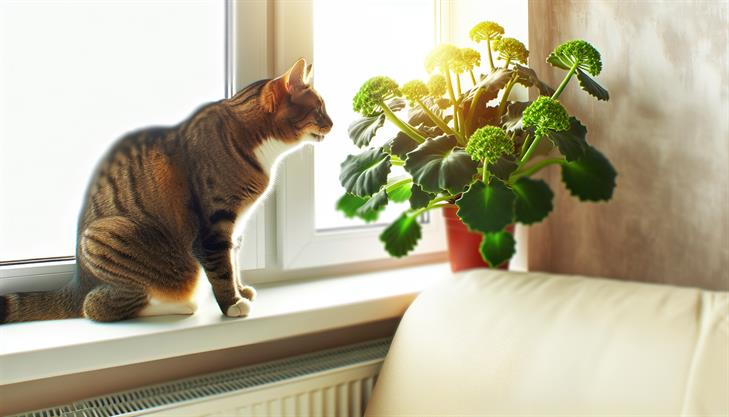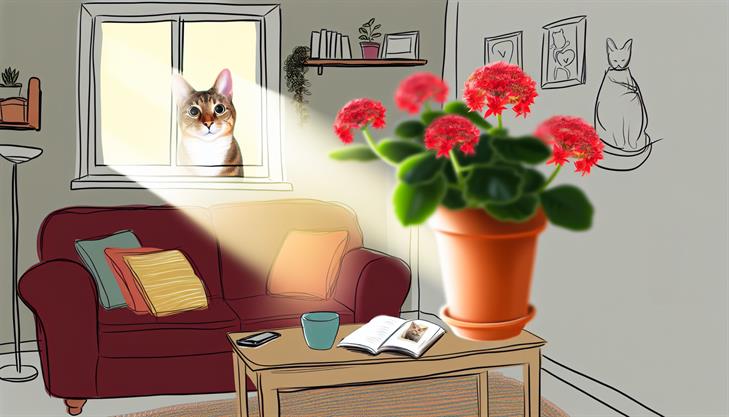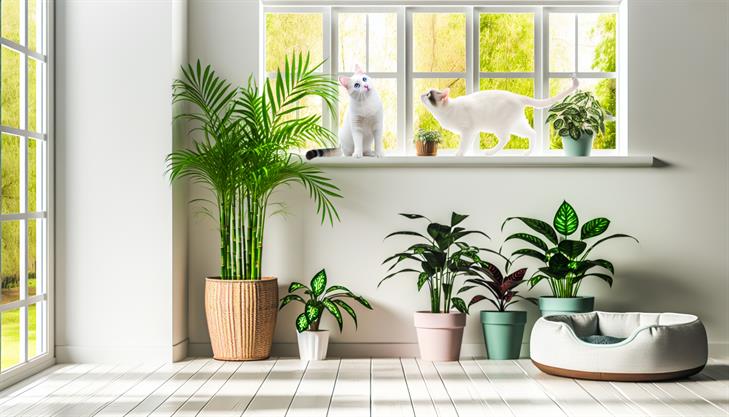If you’re both a plant aficionado and a cat lover, your home likely resembles a vibrant oasis filled with luscious greenery and the soothing presence of your feline friends. Among your treasured plant collection might be the charming Kalanchoe, known for its vibrant, waxy leaves and clusters of delicate flowers. But, as any pet parent will tell you, curiosity is second nature to cats, making it vital to ensure that every element of your home is safe for them—plants included. Are you left wondering, "Is the Kalanchoe plant poisonous to my feline companion?" You’re not alone. Many pet owners face this dilemma, and understanding which plants pose risks could make all the difference. This guide will not only demystify the safety concerns surrounding Kalanchoe plants but also offer practical tips on maintaining a cat-friendly home without sacrificing your love for greenery. Whether you’re planning your next plant addition or reassessing your current collection, read on to ensure peace of mind for both you and your whiskered roommate.
Understanding Kalanchoe Plants: An Overview
Kalanchoe plants are popular among houseplant enthusiasts for their vibrant flowers and low maintenance needs, but as a pet owner, it’s crucial to understand their potential risks, especially around household pets like cats. The short answer to the question "Is kalanchoe plant poisonous to cats?" is yes, kalanchoe plants can be toxic to cats if ingested.
Kalanchoe plants contain compounds known as bufadienolides, which are cardiac glycosides. These compounds are toxic to cats and can lead to serious health concerns if a significant amount of the plant is eaten. Common symptoms of kalanchoe poisoning in cats include drooling, vomiting, and diarrhea. In more severe cases, the ingestion of kalanchoe can lead to abnormal heart rhythms, which can be life-threatening if not addressed promptly.
If you suspect that your cat has ingested any part of a kalanchoe plant, it’s important to act quickly. Here’s a step-by-step guide on what you should do:
-
Remove the Plant: Immediately move the kalanchoe plant to an area that is inaccessible to your pets. This prevents further ingestion.
-
Observe Your Cat: Begin monitoring your cat for any signs of toxicity. Even if your cat seems fine initially, symptoms can develop over time.
-
Contact a Veterinarian: Call your veterinarian right away if your cat shows symptoms or if you know your cat has ingested part of the plant. Provide them with information on how much of the plant was eaten and the time of ingestion.
-
Follow Professional Advice: Your veterinarian may instruct you to bring your cat in for an examination or suggest specific treatments like induced vomiting or administration of activated charcoal to limit toxin absorption.
For prevention, consider the following tips:
- Placement of Plants: Keep kalanchoe and other potentially toxic plants in areas your cats cannot reach. Hanging planters or high shelves can be a good option.
- Alternative Plants: If your household includes curious cats that frequently chew on houseplants, consider keeping non-toxic plants. Species such as spider plants or Boston ferns are safer options.
- Training: Although it can be challenging, training your cat to avoid certain areas or using deterrents can minimize the risk of them accessing potentially harmful plants.
In summary, while kalanchoe plants are a beautiful and easy-to-care-for addition to your home, they do pose a risk to feline friends. Being aware of the symptoms of kalanchoe toxicity and having a plan in place can help ensure your home remains a safe environment for both your plants and your pets. Always consult with a veterinarian if you have concerns about your cat’s health in relation to plant exposure.
How Kalanchoe Affects Cats: Symptoms and Risks
Kalanchoe plants are popular for their vibrant, beautiful blooms, which add a touch of elegance to homes and gardens. However, if you’re a cat owner, it’s crucial to understand that kalanchoe plants can pose a significant risk to your feline friends. The answer to the question "is kalanchoe plant poisonous to cats" is indeed a resounding yes. Kalanchoe contains toxic compounds that can adversely affect cats if ingested.
Understanding the Toxicity
The main compounds responsible for the toxicity are bufadienolides, which are cardiac glycosides. These compounds primarily affect the cardiac and neurological systems of cats. Even small amounts of the plant can lead to symptoms of poisoning, so it’s essential to keep kalanchoe plants out of your cat’s reach.
Recognizing the Symptoms
If a cat ingests kalanchoe, you may notice a range of symptoms that can vary depending on the amount ingested. Common symptoms include:
-
Gastrointestinal Issues: Vomiting and diarrhea are often the first signs, as the cat’s digestive system reacts to the toxins.
-
Cardiac Symptoms: More severe cases can result in abnormal heart rhythms and changes in heart rate. These symptoms are a result of the cardiac glycosides affecting heart function.
-
Neurological Symptoms: These may include lethargy, weakness, and in severe cases, tremors or seizures.
Immediate Actions to Take
If you suspect your cat has ingested any part of a kalanchoe plant, prompt action is critical:
-
Remove Access: First, ensure that your cat can’t access the plant again by removing it from the area.
-
Check and Clear Their Mouth: Gently open your cat’s mouth to check for any plant material, and if safe to do so, carefully remove any visible remnants to prevent further ingestion.
-
Contact a Veterinarian: Call your veterinarian immediately for advice. They may instruct you to bring your cat in for a check-up, depending on the severity of the symptoms.
-
Induce Vomiting: Only induce vomiting if directed by a professional, as incorrect handling can cause more harm.
-
Bring a Sample: If possible, bring a sample or a photo of the plant to the veterinarian to assist in treatment.
Prevention Tips
To avoid the risk altogether, consider these preventive measures:
-
Alternative Plants: Decorate with non-toxic plants such as spider plants or Boston ferns, which are safe for pets.
-
High Placement: If you must have kalanchoe in your home, place it in an area that’s completely inaccessible to cats, such as on high shelves or hanging baskets.
-
Cat Deterrents: Use safe cat deterrents and sprays around plants to discourage chewing.
-
Observing Behavior: Keep an eye on your cat’s behavior around plants to catch any issues early.
By taking these precautions and acting swiftly in the case of ingestion, you can help ensure the safety and health of your feline companions while enjoying your favorite plants.
Prevention Tips for Keeping Your Cat Safe
Kalanchoe plants, often admired for their vibrant flowers and succulent leaves, are a popular choice for indoor and outdoor gardens. However, if you’re a cat owner, it’s crucial to understand the potential risks these plants pose to your feline friends. The kalanchoe plant is indeed poisonous to cats, and ingesting any part of it can lead to severe health issues.
Understanding the Risks:
Kalanchoe plants contain bufadienolides, a type of cardiac toxin. If a cat chews or ingests this plant, these toxins can lead to a range of symptoms from mild gastrointestinal upset to more serious cardiac disturbances. Common symptoms include vomiting, diarrhea, drooling, and lethargy. In severe cases, ingestion might result in abnormal heart rhythms, seizures, or even death.
Prevention Tips for Cat Owners:
-
Choose Pet-Safe Plants: If you’re planning to add indoor plants to your home or garden, opt for non-toxic varieties like spider plants, bamboo palm, or Boston ferns. These choices are not only safe but also easy to maintain.
-
Strategic Placement: Keep kalanchoe plants out of your cat’s reach. This might involve placing them in high, inaccessible areas or using hanging planters. Ensure there are no nearby surfaces that your cat can climb to reach the plants.
-
Training and Deterrents: Train your cat to stay away from plants using positive reinforcement techniques. Additionally, consider using deterrents such as citrus sprays around the base of the plant – many cats find the smell unpleasant.
-
Physical Barriers: If necessary, use physical barriers like plant cages or decorative rocks to cover the soil and stem, making it difficult for curious cats to nibble on the plants.
-
Regular Monitoring: Regularly check your plants and ensure that no leaves have fallen to the ground, as these can easily become a target for playful cats.
-
Create a Cat-Friendly Space: Offer your cat an alternative by creating a dedicated play area with cat grass or other cat-safe plants. This not only diverts their attention but satisfies their natural craving to chew greenery.
What to Do If Ingestion Occurs:
If you suspect your cat has ingested part of a kalanchoe plant, immediate action is essential. Contact your veterinarian or an emergency animal hospital as quickly as possible. Provide details about the plant and the symptoms observed to help the veterinarian administer the appropriate treatment.
Additional Advice:
Having a safe environment for your pets requires vigilance and knowledge. Regularly educate yourself on the plants around your home, both indoor and outdoor. It’s also beneficial to post a list of emergency contacts, including your vet’s phone number and a local animal poison control center, in an easily accessible location.
By proactively managing your household environment and choosing the right plants, you can enjoy the beauty of flora while ensuring your pets remain safe and healthy.
Safe Alternatives to Kalanchoe for Cat Owners
Cats are curious creatures, often exploring their environment with a sometimes worrying enthusiasm. For cat owners with a green thumb, it’s crucial to be aware of which plants might pose a risk to their feline friends. One plant that requires particular caution is the kalanchoe. Understanding whether the kalanchoe plant is poisonous to cats is vital for ensuring the safety and wellbeing of your pet.
The kalanchoe plant is indeed toxic to cats. These succulents, although popular for their low maintenance and attractive flowers, contain compounds called bufadienolides. These substances can be harmful if ingested by cats, leading to gastrointestinal issues and, in severe cases, more critical health problems like heart issues.
Common Symptoms of Kalanchoe Poisoning in Cats
If a cat ingests parts of the kalanchoe plant, they may exhibit symptoms such as:
- Vomiting
- Diarrhea
- Drooling
- Lethargy
- Changes in heart rate
In extreme cases, the ingestion could potentially lead to life-threatening conditions, such as heart arrhythmias or seizures. Therefore, it’s important to act swiftly if poisoning is suspected.
Steps to Take if Your Cat Ingests Kalanchoe
-
Identify the Plant: Ensure you are aware that your cat has ingested kalanchoe. Check your home for missing plant parts or see your cat chewing on the plant.
-
Monitor Symptoms: Watch your cat closely for the symptoms listed above. Note any changes in behavior or health.
-
Contact Your Veterinarian: Immediately reach out to your veterinarian for advice specific to your cat’s condition. Provide them with details about the plant and the amount possibly ingested.
-
Follow Professional Advice: Your vet may ask you to bring your cat in for treatment, which could include administering activated charcoal, intravenous fluids, or medications to manage symptoms.
Safe Alternatives to Kalanchoe for Cat Owners
Fortunately, there are numerous cat-friendly plants that can beautify your home without posing a risk to your pet:
-
Spider Plants: Not only are spider plants safe for cats, but they also help purify the air.
-
Areca Palms: These add a tropical touch to your home and are non-toxic to cats.
-
Boston Ferns: This lush green plant is safe for felines and thrives in humid environments.
-
Bamboo Palm: Adds elegance to any room and is harmless to pets.
Setting Up a Safe Plant Environment
To create a safe environment if you choose to keep kalanchoe or other potentially toxic plants, consider these tips:
-
Placement: Place the plant out of reach on high shelves or in hanging baskets.
-
Barriers: Use decorative cages or terrariums to house small plants and keep curious paws away.
-
Training: Train your cat not to nibble on plants with deterrents or by using distractions like toys.
By being informed about the effects of kalanchoe on cats and opting for safer plant alternatives, you can enjoy a lush indoor garden while ensuring the safety of your feline companions. Always consult your vet if you’re unsure about any plant’s compatibility with your pets.
What to Do If Your Cat Ingests Kalanchoe
If you’re a cat owner and have a kalanchoe plant in your home, it’s important to be aware of the potential risks it poses to your feline friend. Kalanchoe plants are, in fact, poisonous to cats. These flowering plants, often admired for their vibrant colors and attractive appearance, can cause mild to severe reactions if ingested by cats.
Understanding the Toxicity
Kalanchoe contains compounds known as bufadienolides, which are toxic to cats. When consumed, these compounds can interfere with the cardiovascular system, leading to various health issues. While every cat may react differently, it’s crucial to recognize the signs of poisoning.
Symptoms of Kalanchoe Poisoning
If your cat ingests any part of a kalanchoe plant, they may exhibit several symptoms. Common signs include:
- Vomiting
- Diarrhea
- Drooling
- Lethargy
- Decreased appetite
In more severe cases, particularly if a large amount of the plant is consumed, symptoms can escalate to:
- Abdominal pain
- Irregular heartbeat
- Tremors
- Seizures
What to Do If Your Cat Ingests Kalanchoe
- Assess the Situation Quickly: Identify how much of the plant your cat has consumed. Gather any visible plant remnants for reference.
- Monitor Your Cat: Keep a close watch on your cat’s behavior and symptoms. Note any changes or escalations in their condition.
- Contact Your Veterinarian Immediately: Even if symptoms seem mild, it’s crucial to seek professional advice as soon as possible. Provide details about your cat’s behavior, symptom progression, and how much of the plant was ingested.
- Follow Veterinary Instructions: Your vet may suggest bringing your cat in for an examination. Follow their advice closely, as treatment might include inducing vomiting, administering activated charcoal, or providing supportive care such as intravenous fluids.
- Remove the Plant: To prevent future incidents, relocate kalanchoe plants out of your cat’s reach or remove them from your home altogether.
Preventive Measures and Additional Advice
- Educate Yourself and Family Members: Make sure everyone in your household is aware of the potential risks linked with kalanchoe and other toxic plants.
- Secure Your Plants: If removing the plant isn’t feasible, ensure it’s placed in an inaccessible area, using plant hangers or high shelves.
- Opt for Pet-Friendly Plants: Consider replacing toxic plants with non-toxic alternatives safe for pets.
- Regular Check-ups: Routine vet visits can help detect any early signs of health issues in your cat, including those caused by accidental ingestion of toxic substances.
In summary, kalanchoe plants, although beautiful, pose a significant risk to cats, making awareness and prevention key factors in ensuring their safety. Remember, quick intervention and veterinary guidance are paramount if you suspect kalanchoe poisoning.
In conclusion, the Kalanchoe plant, while a beautiful addition to any home, poses a significant risk to our feline companions. Cats are susceptible to the toxic compounds found in Kalanchoe, which can lead to serious health issues if ingested. Symptoms of poisoning can range from mild gastrointestinal distress to more severe reactions such as abnormal heart rhythms or seizures. It’s crucial for cat owners to be aware of these dangers and take necessary precautions to ensure their pets’ safety.
As a responsible pet owner, consider opting for cat-friendly plants or placing Kalanchoe in areas inaccessible to curious paws and noses. If you suspect your cat has ingested part of a Kalanchoe plant, seek immediate veterinary assistance.
Finally, my recommendation is to regularly review and research all plants in your home for potential risks to pets. Staying informed and vigilant can create a harmonious and safe environment for both your feline friends and your indoor garden.


